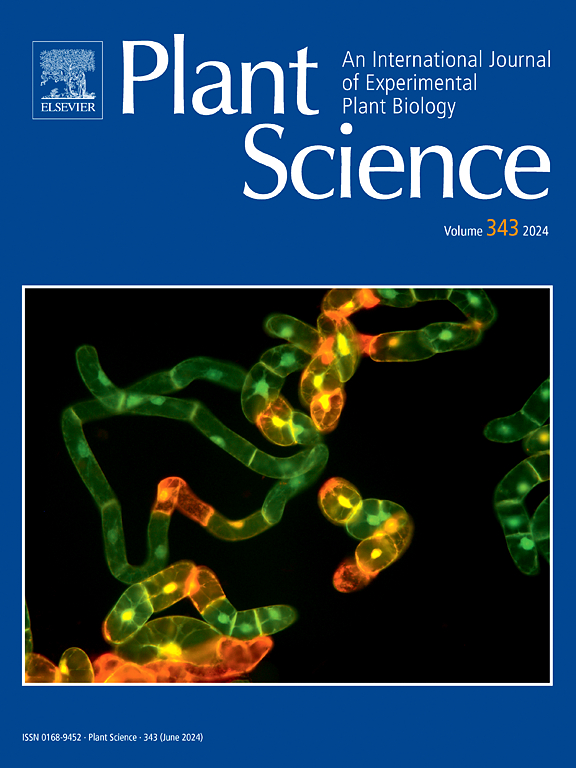Silicon oxide nanoparticles boost rice resilience to salinity by enhancing antioxidant defenses and stress regulation
IF 4.2
2区 生物学
Q2 BIOCHEMISTRY & MOLECULAR BIOLOGY
引用次数: 0
Abstract
Salinity stress is one of the most detrimental abiotic factors affecting plant development, harming vast swaths of agricultural land worldwide. Silicon is one element that is obviously crucial for the production and health of plants. With the advent of nanotechnology in agricultural sciences, the application of silicon oxide nanoparticles (SiO-NPs) presents a viable strategy to enhance sustainable crop production. The aim of this study was to assess the beneficial effects of SiO-NPs on the morpho-physio-biochemical parameters of rice (Oryza sativa L., variety: DRR Dhan 73) under both normal and saline conditions. To create salt stress during transplanting, 50 mM NaCl was injected through the soil. 200 mM SiO-NPs were sprayed on the leaves 25 days after sowing (DAS). It was evident that salt stress significantly hindered rice growth because of the reductions in shot length (41 %), root length (38 %), shot fresh mass (40 %), root fresh mass (47 %), shoot dry mass (48 %), and root dry mass (39 %), when compared to controls. Together with this growth inhibition, elevated oxidative stress markers including a 78 % increase in malondialdehyde (MDA) and a 67 % increase in hydrogen peroxide (H2O2) indicating enhanced lipid peroxidation were noted. Increasing the chlorophyll content (14 %), photosynthetic rate (11 %), protein levels, total free amino acids (TFAA; 13 %), and total soluble sugars (TSS; 11 %), all help to boost nitrogen (N; 16 %), phosphorous (P; 14 %), potassium (K; 12 %), and vital nutrients. The adverse effects of salt stress were significantly reduced by exogenous application of SiO-NPs. Additionally; SiO-NPs dramatically raised the activity of important antioxidant enzymes such as superoxide dismutase (SOD), peroxidase (POX), and catalase (CAT), improving the plant's ability to scavenge reactive oxygen species (ROS) and thereby lowering oxidative damage brought on by salt. This study highlights SiO-NPs' potential to develop sustainable farming practices and provides significant new insights into how they enhance plant resilience to salinity, particularly in salt-affected regions worldwide.
氧化硅纳米颗粒通过增强抗氧化防御和应激调节来增强水稻对盐度的恢复能力
盐胁迫是影响植物发育的最有害的非生物因素之一,危害着世界范围内大片的农业用地。硅显然是一种对植物的生长和健康至关重要的元素。随着纳米技术在农业科学中的应用,氧化硅纳米颗粒(SiO-NPs)的应用为提高作物可持续生产提供了可行的策略。本研究的目的是评估在正常和盐水条件下SiO-NPs对水稻(Oryza sativa L.,品种:DRR Dhan 73)形态生理生化参数的有益影响。为了在移栽过程中产生盐胁迫,在土壤中注入50 mM NaCl。播种后25 d (DAS)喷施200 mM SiO-NPs。与对照相比,盐胁迫显著抑制了水稻的生长,使茎长(41 %)、根长(38 %)、茎干质量(40 %)、根干质量(47 %)、茎干质量(48 %)和根干质量(39 %)降低。与这种生长抑制一起,氧化应激标志物升高,包括丙二醛(MDA)增加78 %和过氧化氢(H2O2)增加67 %,表明脂质过氧化作用增强。提高叶绿素含量(14 %)、光合速率(11 %)、蛋白质水平、总游离氨基酸(TFAA;13 %),总可溶性糖(TSS;11 %),都有助于提高氮(N;16 %),磷(P;14 %),钾(K;12 %)和重要的营养物质。外源施用sio2 - nps显著降低了盐胁迫的不利影响。另外;SiO-NPs显著提高了植物的超氧化物歧化酶(SOD)、过氧化物酶(POX)和过氧化氢酶(CAT)等重要抗氧化酶的活性,提高了植物清除活性氧(ROS)的能力,从而降低了盐对植物的氧化损伤。这项研究强调了SiO-NPs在发展可持续农业实践方面的潜力,并为它们如何增强植物抗盐能力提供了重要的新见解,特别是在全球受盐影响的地区。
本文章由计算机程序翻译,如有差异,请以英文原文为准。
求助全文
约1分钟内获得全文
求助全文
来源期刊

Plant Science
生物-生化与分子生物学
CiteScore
9.10
自引率
1.90%
发文量
322
审稿时长
33 days
期刊介绍:
Plant Science will publish in the minimum of time, research manuscripts as well as commissioned reviews and commentaries recommended by its referees in all areas of experimental plant biology with emphasis in the broad areas of genomics, proteomics, biochemistry (including enzymology), physiology, cell biology, development, genetics, functional plant breeding, systems biology and the interaction of plants with the environment.
Manuscripts for full consideration should be written concisely and essentially as a final report. The main criterion for publication is that the manuscript must contain original and significant insights that lead to a better understanding of fundamental plant biology. Papers centering on plant cell culture should be of interest to a wide audience and methods employed result in a substantial improvement over existing established techniques and approaches. Methods papers are welcome only when the technique(s) described is novel or provides a major advancement of established protocols.
 求助内容:
求助内容: 应助结果提醒方式:
应助结果提醒方式:


